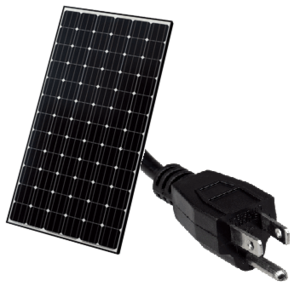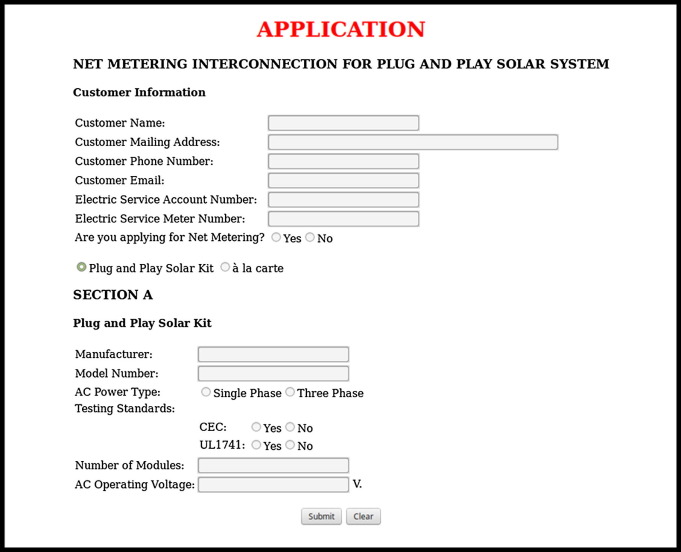J.M.Pearce (talk | contribs) m (→Source) |
J.M.Pearce (talk | contribs) mNo edit summary |
||
| Line 5: | Line 5: | ||
* Aishwarya S. Mundada, , Yuenyong Nilsiam , Joshua M. Pearce. [http://dx.doi.org/10.1016/j.solener.2016.06.002 A review of technical requirements for plug-and-play solar photovoltaic microinverter systems in the United States]. ''Solar Energy'' '''135''', (2016), pp. 455–470. doi: 10.1016/j.solener.2016.06.002 [open access soon] | * Aishwarya S. Mundada, , Yuenyong Nilsiam , Joshua M. Pearce. [http://dx.doi.org/10.1016/j.solener.2016.06.002 A review of technical requirements for plug-and-play solar photovoltaic microinverter systems in the United States]. ''Solar Energy'' '''135''', (2016), pp. 455–470. doi: 10.1016/j.solener.2016.06.002 [open access soon] | ||
==Abstract== | ==Abstract== | ||
The average American is highly supportive of solar photovoltaic (PV) technology and has the opportunity to earn a high return of investment from a PV investment for their own home. Unfortunately, the average American does not have easy access to capital/financing to install a PV system able to meet their aggregate annual electric needs. One method to overcome this challenge is to allow ‘plug-and-play solar’, which is defined as a fully inclusive, commercial, off-the-shelf PV system (normally consisting of a PV module and microinverter), which a prosumer can install by plugging it into an electric outlet and avoiding the need for significant permitting, inspection and interconnection processes. Many advanced countries already allow plug-and-play solar, yet U.S. regulations have lagged behind. In order to assist the U.S. overcome regulatory obstructions to greater PV penetration, this article first reviews the relevant codes and standards from the National Electric Code, local jurisdictions and utilities for PV with a specific focus on plug-and-play solar. Next, commercially available microinverters and alternating current (AC) modules are reviewed for their technical and safety compliance to these standards and all were found to be compliant. The technical requirements are then compared to regulatory and utility requirements using case studies in Michigan, which were found to create arbitrary non-technically-valid barriers to grid entry. The analysis also exposed the redundancy of the utility accessed AC disconnect switch for residential and small commercial grid connected solar PV. It is clear that the AC disconnect switch is not necessary technically and thus imposing it is an economic barrier to grid entry for solar PV systems with UL (Underwriters Laboratories) certified microinverters. To reduce consumer and utility workload and the concomitant soft costs, this article provides a streamlined application with only technical requirements and free and open source software to ease utility implementation. Finally, the advantages of supporting plug-and-play solar PV with UL certified microinverters include greater PV system performance, faster uptake and higher PV penetration levels, improved prosumer economics, and more environmentally responsible electric generation. | The average American is highly supportive of solar photovoltaic (PV) technology and has the opportunity to earn a high return of investment from a PV investment for their own home. Unfortunately, the average American does not have easy access to capital/financing to install a PV system able to meet their aggregate annual electric needs. One method to overcome this challenge is to allow ‘plug-and-play solar’, which is defined as a fully inclusive, commercial, off-the-shelf PV system (normally consisting of a PV module and microinverter), which a prosumer can install by plugging it into an electric outlet and avoiding the need for significant permitting, inspection and interconnection processes. Many advanced countries already allow plug-and-play solar, yet U.S. regulations have lagged behind. In order to assist the U.S. overcome regulatory obstructions to greater PV penetration, this article first reviews the relevant codes and standards from the National Electric Code, local jurisdictions and utilities for PV with a specific focus on plug-and-play solar. Next, commercially available microinverters and alternating current (AC) modules are reviewed for their technical and safety compliance to these standards and all were found to be compliant. The technical requirements are then compared to regulatory and utility requirements using case studies in Michigan, which were found to create arbitrary non-technically-valid barriers to grid entry. The analysis also exposed the redundancy of the utility accessed AC disconnect switch for residential and small commercial grid connected solar PV. It is clear that the AC disconnect switch is not necessary technically and thus imposing it is an economic barrier to grid entry for solar PV systems with UL (Underwriters Laboratories) certified microinverters. To reduce consumer and utility workload and the concomitant soft costs, this article provides a streamlined application with only technical requirements and free and open source software to ease utility implementation. Finally, the advantages of supporting plug-and-play solar PV with UL certified microinverters include greater PV system performance, faster uptake and higher PV penetration levels, improved prosumer economics, and more environmentally responsible electric generation. | ||
[[image:streamkit.jpg|right]] | [[image:streamkit.jpg|right]] | ||
==Free software for Utilities== | |||
* In order to host the web application, a server machine with a web server (Apache HTTP server), PHP interpreter, and MySQL database installed is needed. Then the web application (application.php) and the SQL code (nmifpapss.sql) can be download from https://github.com/mtu-most/Net-Meter-Solar-App. | |||
==Keywords== | ==Keywords== | ||
AC disconnect switch; [[Distributed generation]]; [[Net metering]]; Net metering application; [[Plug and play solar]]; [[Photovoltaic]]; [[Levelized cost of electricity]]; | AC disconnect switch; [[Distributed generation]]; [[Net metering]]; Net metering application; [[Plug and play solar]]; [[Photovoltaic]]; [[Levelized cost of electricity]]; | ||
Revision as of 00:59, 17 June 2016

Source
- Aishwarya S. Mundada, , Yuenyong Nilsiam , Joshua M. Pearce. A review of technical requirements for plug-and-play solar photovoltaic microinverter systems in the United States. Solar Energy 135, (2016), pp. 455–470. doi: 10.1016/j.solener.2016.06.002 [open access soon]
Abstract
The average American is highly supportive of solar photovoltaic (PV) technology and has the opportunity to earn a high return of investment from a PV investment for their own home. Unfortunately, the average American does not have easy access to capital/financing to install a PV system able to meet their aggregate annual electric needs. One method to overcome this challenge is to allow ‘plug-and-play solar’, which is defined as a fully inclusive, commercial, off-the-shelf PV system (normally consisting of a PV module and microinverter), which a prosumer can install by plugging it into an electric outlet and avoiding the need for significant permitting, inspection and interconnection processes. Many advanced countries already allow plug-and-play solar, yet U.S. regulations have lagged behind. In order to assist the U.S. overcome regulatory obstructions to greater PV penetration, this article first reviews the relevant codes and standards from the National Electric Code, local jurisdictions and utilities for PV with a specific focus on plug-and-play solar. Next, commercially available microinverters and alternating current (AC) modules are reviewed for their technical and safety compliance to these standards and all were found to be compliant. The technical requirements are then compared to regulatory and utility requirements using case studies in Michigan, which were found to create arbitrary non-technically-valid barriers to grid entry. The analysis also exposed the redundancy of the utility accessed AC disconnect switch for residential and small commercial grid connected solar PV. It is clear that the AC disconnect switch is not necessary technically and thus imposing it is an economic barrier to grid entry for solar PV systems with UL (Underwriters Laboratories) certified microinverters. To reduce consumer and utility workload and the concomitant soft costs, this article provides a streamlined application with only technical requirements and free and open source software to ease utility implementation. Finally, the advantages of supporting plug-and-play solar PV with UL certified microinverters include greater PV system performance, faster uptake and higher PV penetration levels, improved prosumer economics, and more environmentally responsible electric generation.

Free software for Utilities
- In order to host the web application, a server machine with a web server (Apache HTTP server), PHP interpreter, and MySQL database installed is needed. Then the web application (application.php) and the SQL code (nmifpapss.sql) can be download from https://github.com/mtu-most/Net-Meter-Solar-App.
Keywords
AC disconnect switch; Distributed generation; Net metering; Net metering application; Plug and play solar; Photovoltaic; Levelized cost of electricity;
See also
- Plug-and-Play Solar Photovoltaic Microinverter Systems
- Review of solar levelized cost
- Performance of U.S. hybrid distributed energy systems: Solar photovoltaic, battery and combined heat and power
- Emerging economic viability of grid defection in a northern climate using solar hybrid systems





